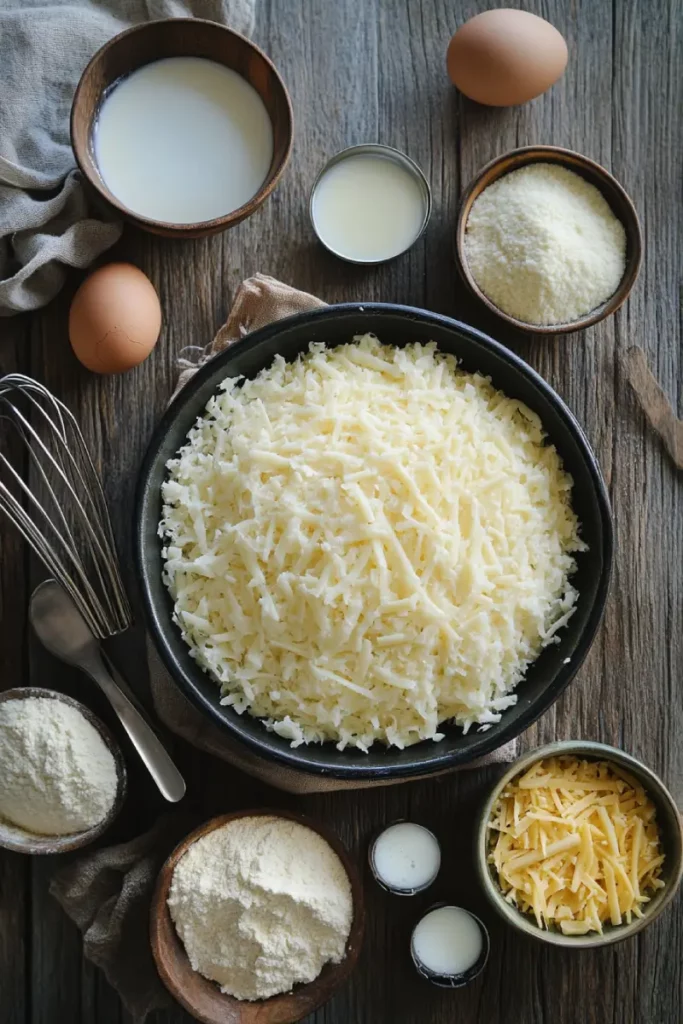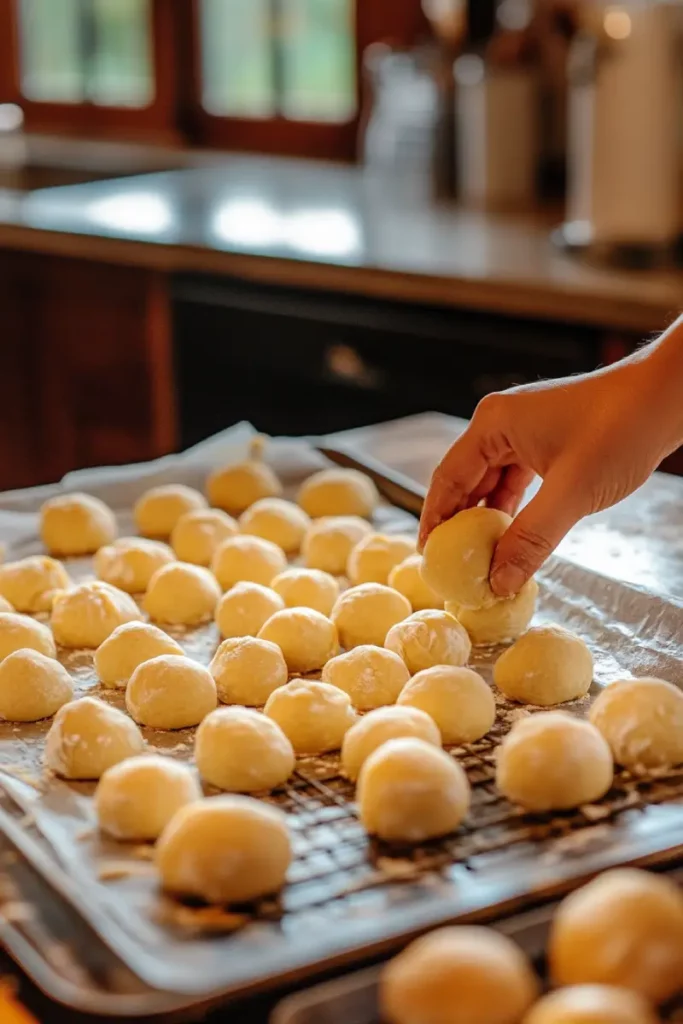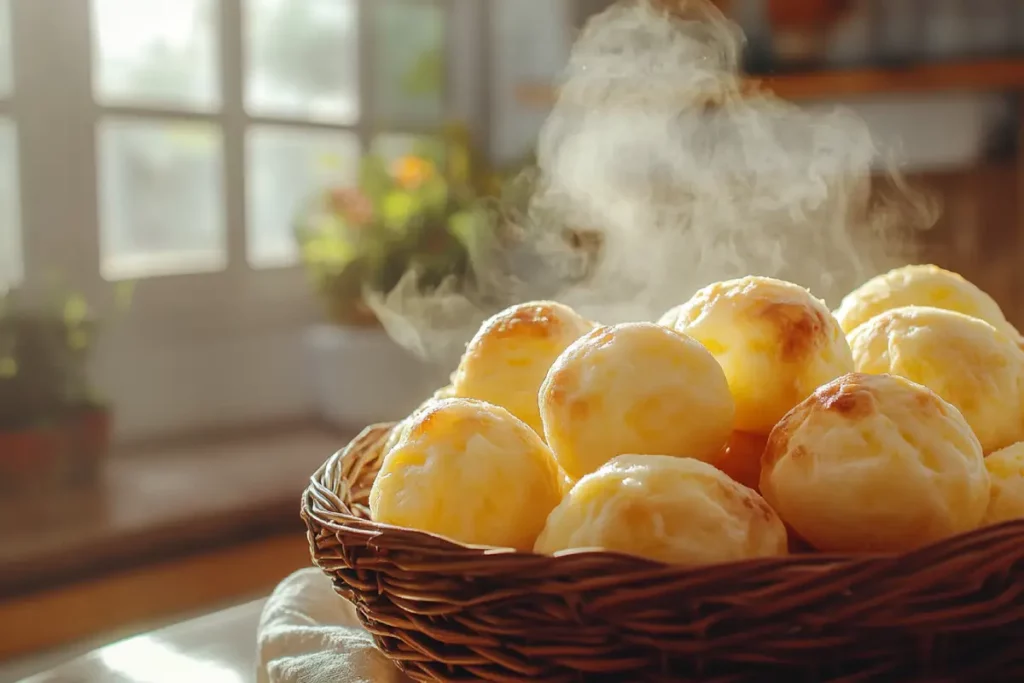Brazilian cheese bread is a warm, chewy treat that’s both naturally gluten-free and wildly delicious. Known as pão de queijo in Brazil, it’s one of the most loved snack breads across South America—and now, it’s winning hearts worldwide. This guide walks you through everything you need to make your own batch of golden, puffy Brazilian cheese bread. From its rich origins to serving tips, freezing techniques, and common mistakes—you’ll find it all right here. Whether you’re hosting a brunch or craving a cheesy snack, this recipe deserves a spot in your kitchen.
Let’s dive into the flavor, texture, and charm that make Brazilian cheese bread unforgettable.
Bold Authentic Flavor of Brazilian Cheese Bread
What Makes Brazilian Cheese Bread Unique
The magic of Brazilian cheese bread lies in its crusty outside and gooey center. Unlike other breads, it’s made with tapioca flour instead of wheat. This gives it a chewy bite and that signature stretch when pulled apart. Brazilian cheese bread also packs a rich cheesy punch—typically using Parmesan or Minas cheese, or a blend of both.
What separates this bread from other cheese-based baked goods is the combination of high heat baking and starch-based dough. It puffs beautifully in the oven without yeast or rising time.
Brazilian cheese bread stands out thanks to:
- Its light, airy inside
- Naturally gluten-free ingredients
- Stretchy, elastic texture
- Sharp cheese flavor in every bite
Origin and Cultural Roots of Pão de Queijo
Pão de queijo dates back to 18th century Brazil. Enslaved African workers in the Minas Gerais region created it using cassava starch and leftover cheese. Over time, it became a staple of Brazilian breakfasts and street food markets.
Today, it’s found in bakeries and cafes across Brazil, often enjoyed with coffee or guava jam. Its popularity has spread globally, especially in the U.S. where Brazilian steakhouses often serve them as appetizers. Homemade versions have surged in popularity thanks to simple recipes and naturally gluten-free appeal.
Whether served warm in a traditional setting or paired with contemporary dishes, Brazilian cheese bread remains a comfort food with deep roots and irresistible flavor.
You can find this minimalist recipe with full prep tips here: Natural Mounjaro Recipe Tea
Ingredients and Substitutions for Brazilian Cheese Bread

Key Ingredients That Make the Difference
Brazilian cheese bread relies on just a handful of pantry staples. Yet, each one plays a big role in flavor and texture. Here’s what you’ll need to make authentic pão de queijo:
- Tapioca flour (or starch): This is the base of the dough. It’s what gives Brazilian cheese bread its chewy, stretchy texture. You can find it in most grocery stores or online.
- Cheese: Traditional recipes call for Minas cheese, a Brazilian staple. But Parmesan, mozzarella, or a combination of both work beautifully. Stick to finely shredded cheese for easier mixing.
- Eggs: These bind the dough and help it puff during baking.
- Milk: Warm milk adds moisture and richness. Some recipes use a mix of milk and water.
- Oil: Neutral oils like vegetable or canola give structure and softness. Some folks prefer butter for added flavor.
Here’s a quick look at the core ingredients in a comparison table:
| Ingredient | Purpose |
|---|---|
| Tapioca Flour | Gives elasticity and chew |
| Cheese (Parmesan, Mozzarella) | Adds flavor and gooey texture |
| Eggs | Helps bind the dough |
| Milk | Moistens and enriches |
| Oil | Softens texture |
Smart Substitutions for Dietary Needs
If you need to make Brazilian cheese bread dairy-free or adapt it for allergies, you’re not out of luck. Many home cooks tweak the classic recipe to fit their needs.
Here are a few popular substitutions:
- Dairy-free cheese: Use plant-based cheese shreds that melt well. Brands like Violife or Daiya offer decent alternatives.
- Almond or oat milk: Works well in place of dairy milk. Stick with unsweetened and unflavored versions.
- Butter instead of oil: This adds a deeper flavor and is often preferred in richer versions.
- No eggs? Some bakers use flax eggs (1 tbsp flaxseed + 3 tbsp water) to bind the dough, though it affects the puffiness slightly.
When adapting the recipe, make small test batches. That way, you can fine-tune your substitutions without wasting ingredients.
Step-by-Step Brazilian Cheese Bread Recipe
Prep, Mix, and Shape Like a Pro
Making Brazilian cheese bread at home is easier than it looks. With a few tools and clear instructions, you’ll have golden puffs of cheesy goodness in under an hour.
Here’s how to prepare it:
1. Preheat your oven: Set it to 375°F (190°C). If using a convection oven, reduce the temperature slightly.
2. Boil the milk and oil: In a saucepan, heat milk, oil, and a pinch of salt until it starts to bubble.
3. Mix with tapioca flour: Pour the hot liquid over the tapioca flour in a large bowl. Stir quickly—this step helps gelatinize the starch.
4. Add eggs: Once the mixture cools slightly, add one egg at a time, stirring until fully combined.
5. Fold in cheese: Stir in finely grated cheese. The dough will be sticky, stretchy, and slightly thick.
6. Scoop and shape: Use a cookie scoop or lightly oiled hands to form small balls.
7. Bake: Line a baking sheet with parchment paper and space the dough balls evenly. Bake for 20–25 minutes or until puffed and golden.

Common Mistakes to Avoid
Even a simple recipe like Brazilian cheese bread can go wrong if a few key steps are missed. Here are the most common pitfalls:
Skipping the heating step: If you don’t pour hot liquid over the tapioca flour, your dough won’t come together. This step helps activate the starch.
Adding cold cheese: Room-temperature cheese blends better into the dough. Cold cheese clumps and affects texture.
Overbaking: Brazilian cheese bread should be slightly golden on the outside but still soft and stretchy inside. If the crust turns too dark, it may dry out.
Using the wrong flour: Only tapioca flour works here. Don’t substitute with cornstarch or all-purpose flour.
Baking and Texture Perfection Tips
How to Get That Classic Crispy-Gooey Finish
The best Brazilian cheese bread has a thin, crisp outer shell with a soft, stretchy inside. Achieving this balance depends on a few key baking techniques.
Use high heat: Bake at 375°F to 400°F. The high temperature helps create steam inside the dough, causing it to puff and crisp on the outside.
Don’t overmix: Once the dough becomes stretchy, stop mixing. Overworking the mixture can make the bread dense instead of airy.
Space the dough balls: Leave room between each portion on the baking sheet. This lets them expand without sticking together.
Watch the color: Brazilian cheese bread turns a light golden brown when done. The crust should feel firm to the touch but not hard. When broken open, the inside should be elastic and slightly gooey.
For extra crispy results, some bakers like to brush the tops with melted butter before baking. Others chill the dough briefly before shaping—it helps with structure and prevents spreading.
You can see these techniques used in this full Brazilian cheese bread recipe that walks through every stage, from prep to plate.
Oven, Air Fryer, or Pan: Which Is Best?
Traditional Brazilian cheese bread is baked in the oven, but modern cooks are using air fryers and even stovetops to save time. Here’s how the methods compare:
- Oven: Best for consistent heat and puffy texture. You can bake large batches at once.
- Air Fryer: Great for small servings. Preheat the air fryer to 350°F and cook for 10–12 minutes. You’ll get crispy exteriors, but they may not rise as much.
- Skillet method: Less common, but possible. Spoon batter onto a hot nonstick pan, like pancakes. It creates a chewy flatbread version, not the classic puff.
Each method changes the outcome slightly, so feel free to experiment and find your favorite.
If you’re looking for more easy and flavorful sides, this homemade salsa roja recipe pairs surprisingly well with cheesy breads—especially for brunch or snacks.
Whether you stick with the oven or branch out to air fryers, the key is to focus on timing and texture. That’s what makes Brazilian cheese bread so irresistible every time.
If you’re following the original at-home method, here’s the recipe that most closely fits the viral version: Brazilian Mounjaro Drink Recipe
Serving and Pairing Brazilian Cheese Bread
What Do You Eat with Brazilian Cheese Bread?
Brazilian cheese bread is versatile and pairs well with both sweet and savory items. In Brazil, it’s often served at breakfast with strong coffee, but it shines at any time of day.
Here are popular and practical pairings:
- Coffee or espresso: The salty richness of the cheese balances beautifully with a bold, bitter cup of coffee.
- Fresh fruit or jam: Guava paste or fig jam adds a subtle sweetness that plays off the cheesy base.
- Soups and stews: Dip Brazilian cheese bread into hearty dishes like feijoada or spicy bean soups.
- Eggs and avocado: Turn it into a brunch plate by pairing it with scrambled eggs and sliced avocado.
Planning a party or brunch spread? Add pão de queijo alongside other finger foods like these easy Argentine empanadas. Their flaky texture complements the chewiness of Brazilian cheese bread perfectly.
And for anyone looking for a lighter option, serve it with a crisp salad and lemon vinaigrette for contrast.
Whether you’re going sweet or savory, this gluten-free snack always fits in.
Serving Ideas for Breakfast, Snacks, and Parties
The beauty of Brazilian cheese bread is that it can adapt to any mealtime.
For breakfast: Serve warm from the oven with black coffee or hot chocolate. In Brazil, it’s a morning staple.
For snacks: Keep a batch in the freezer and reheat when guests arrive. Serve with dipping sauces like chimichurri, garlic aioli, or even spicy tomato salsa.
For parties: Bake mini versions using a smaller scoop. These bite-sized treats vanish fast at gatherings. Pair them with a selection of spreads or soft cheeses on the side.
You can even build a themed platter with Brazilian elements like olives, cured meats, and cassava fries. Add pão de queijo right at the center.
Looking to go further? Serve Brazilian cheese bread with this 2-ingredient version as a quick add-on for unexpected guests. They won’t know it only took minutes.

Storage, Reheating, and Freezing Guide
Can I Freeze Pão de Queijo?
Yes, you absolutely can. One of the best things about Brazilian cheese bread is how well it freezes—both before and after baking. This makes it perfect for meal prep, party planning, or just having a warm snack on demand.
Freezing before baking:
Once your dough balls are shaped, place them on a tray lined with parchment paper. Freeze for 1–2 hours until solid, then transfer them to a zip-top bag or airtight container. They’ll keep for up to 2 months. When ready to bake, pop them straight into the oven—no thawing needed. Just add 2–3 extra minutes to the bake time.
Freezing after baking:
Already baked a batch? Let them cool completely, then store in freezer bags. To reheat, use an oven or air fryer to bring back their crisp outside. Microwaves tend to make them rubbery, so avoid that if possible.
Best Reheating Methods to Keep Them Fresh
Brazilian cheese bread is at its best when warm and slightly gooey inside. If you’ve stored extras, reheating them the right way makes all the difference.
Oven method:
Preheat to 350°F and bake for 5–7 minutes. This restores the crust and soft interior.
Air fryer method:
Set the temperature to 325°F and heat for 4–6 minutes. It brings back a crispy texture quickly and works great for small batches.
Avoid microwaving unless you’re in a rush. It softens the outside but often overcooks the inside, ruining the chewy center Brazilian cheese bread is known for.
If you’re meal-prepping snacks ahead of time, pair your cheese bread with freezer-ready recipes like crispy yuca fries for a well-rounded spread.
You can also check this full Brazilian cheese bread recipe for step-by-step instructions and tips that help with storage and reheating success.
Brazilian Cheese Bread FAQs Answered
Is Brazilian Cheese Bread Supposed to Be Gooey in the Middle?
Yes, and that’s exactly what makes it so irresistible. Authentic Brazilian cheese bread has a chewy, elastic center with a crispy shell. That gooey middle is thanks to the tapioca flour, which reacts differently than regular wheat flour. It stretches when baked, giving pão de queijo its signature bite.
If the inside feels undercooked, don’t worry—it’s supposed to be slightly moist. Just make sure the outside is golden and puffed. You can also refer to this full Brazilian cheese bread recipe to see the ideal texture at each step.
For a firmer inside, bake a minute or two longer, but be careful not to dry it out. That soft, cheesy core is part of the charm.
Is Brazilian Cheese Bread Good? Honest Answer
Absolutely—it’s more than good. It’s addictive. Whether fresh from the oven or reheated the next day, Brazilian cheese bread offers the perfect balance of saltiness, crunch, and chew. Plus, it’s naturally gluten-free, making it a hit with anyone avoiding wheat.
People love it for its versatility. Serve it at brunch with coffee, alongside stews, or even on a charcuterie board. It pairs well with Brazilian classics like feijoada or modern snacks like crispy yuca fries.
Whether you’re gluten-free or just love cheese, this snack is worth baking again and again.
PART 8: Health, Gluten-Free Benefits, and Nutrition Facts
Is Pão de Queijo Gluten-Free?
Yes, Brazilian cheese bread is naturally gluten-free. That’s one of the reasons it has gained popularity beyond Brazil. Instead of wheat, it uses tapioca flour—a starchy extract from the cassava root. This makes it safe for people with gluten intolerance or celiac disease.
You don’t need to make any adjustments to enjoy this recipe gluten-free. Just make sure to choose verified gluten-free cheese and starch if you’re highly sensitive. It’s a simple switch for those avoiding traditional bread without giving up flavor or texture.
Nutritional Value and Portion Tips
Brazilian cheese bread is rich and filling, thanks to its combination of cheese, oil, and eggs. While it’s not low in calories, it fits well into a balanced diet when eaten in moderation.
Here’s a general nutrition breakdown for one medium piece (approx. 25g):
| Nutrient | Amount per Piece |
|---|---|
| Calories | 90–110 kcal |
| Protein | 2–3g |
| Fat | 5–6g |
| Carbohydrates | 10–12g |
The combination of carbs and fat makes it satisfying, but be mindful of portions—especially when pairing with richer dishes like Brazilian feijoada.
To reduce fat, use part-skim mozzarella instead of full-fat cheese. For a lower-calorie option, try the 2-ingredient pão de queijo version, which keeps the texture while simplifying the recipe.
FAQs About Brazilian Cheese Bread
What do you eat with Brazilian cheese bread?
Brazilian cheese bread pairs well with everything from coffee to hearty stews. At breakfast, it’s common to serve it with a cup of strong black coffee or hot chocolate. For savory meals, it complements dishes like feijoada or roasted meats. You can even pair it with fruit jams or soft cheeses for contrast. Looking for inspiration? Try it alongside these easy Argentine empanadas or crispy yuca fries for a flavorful party spread.
Is Brazilian cheese bread supposed to be gooey in the middle?
Yes. A soft, stretchy center is one of the signature traits of authentic Brazilian cheese bread. The outside should be crisp and golden, but the inside should feel moist and elastic. That gooey texture is caused by the tapioca flour, which behaves differently than wheat flour. If the center feels undercooked but the outside is fully baked, you likely nailed it. For the right technique, follow this traditional Brazilian cheese bread recipe.
Is Brazilian cheese bread good?
Absolutely. It’s one of Brazil’s most beloved comfort foods for a reason. Each bite combines the crunch of the crust with cheesy, chewy warmth inside. It’s satisfying, naturally gluten-free, and great for nearly any occasion—breakfast, snack, or side. Don’t take our word for it—make a batch using this quick 2-ingredient Brazilian cheese bread version and see for yourself.
Can I freeze pão de queijo?
Yes, Brazilian cheese bread freezes extremely well. You can freeze the dough before baking, or freeze fully baked pieces. Just place shaped dough balls on a tray, freeze until solid, then store in a sealed bag. Bake from frozen by adding 2–3 extra minutes. To reheat baked bread, use an oven or air fryer to restore crispness. For step-by-step freezing tips, check this full Brazilian cheese bread how-to.
Conclusion
Brazilian cheese bread is more than just a snack—it’s a global favorite with deep cultural roots and irresistible flavor. Whether you make it from scratch or go with the 2-ingredient shortcut, it’s easy to see why pão de queijo has fans worldwide. It’s naturally gluten-free, simple to freeze, and perfect for breakfast, parties, or any moment that calls for something warm and cheesy.
Ready to make your own batch? Follow this complete Brazilian cheese bread recipe and experience the perfect blend of crunch and stretch for yourself.



